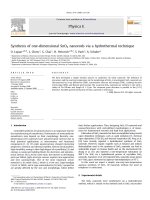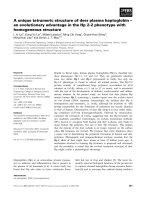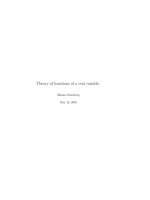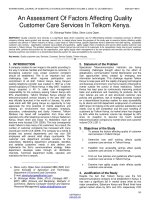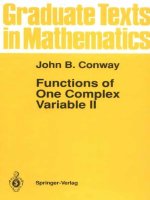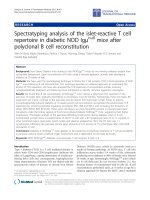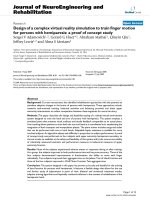john b conway functions of one complex variable ii graduate texts in mathematics pt 2 1995
Bạn đang xem bản rút gọn của tài liệu. Xem và tải ngay bản đầy đủ của tài liệu tại đây (11.93 MB, 412 trang )
John B. Conway
Functions of
One Complex
Variable II
Springer-Verlag
Graduate Texts in Mathematics
159
Editorial Board
J.H.
Ewing F.W. GehringP.R. Halmos
Graduate Texts in Mathematics
I
TAKELJTI/ZARING. Introduction to Axiomatic
Set Theory. 2nd ed.
2
OXTORY. Measure and Category. 2nd ed.
3
SCHAEFER. Topological Vector Spaces.
4HILroN/SrAMMBAcH. A Coursein
Homological Algebra.
5
MAC LANE. Categoriesfor
theWorking
Mathematician.
6HUGHES/PIPER. Projective Planes.
7 A Course
in Arithmetic.
8
TAKEUTI/ZARING.
Axiomatic SetTheory.
9
HUMPIIREYS.introduction to Lie Algebras
and Representation Theory.
10
COHEN. A Course in Simple Homotopy
Theory.
II
CONWAY.Functions of
One Complex
Variable 1.
2nd ed.
12
BEALS.
Advanced Mathematical Analysis.
13
ANDERSON/FULLER. Rings
andCategories of
Modules. 2nd ed.
14GOLuBITSKY/GUILLEMIN. Stable Mappings
and Their Singularities.
IS
BERRERIAN. Lectures in Functional Analysis
and Operator Theory.
16
WINTER. The Structure of Fields.
l7
ROSENBLATF. Random Processes. 2nd ed.
18HALMOS. Measure Theory.
19HALMOS.A
Hilbert
Space Problem Book.
2nd ed.
20
HUSEMOLLER. Fibre Bundles. 3rd ed.
21
HUMPHREYS. Linear Algebraic Groups.
22
BARNES/MACK. An Algebraic Introduction to
Mathematical Logic.
23
GREUB. Linear Algebra. 4th ed.
24HOLMES. Geometric Functional Analysis and
Its Applications.
25
HEWETr/STROMBERG. Real and Abstract
Analysis.
26
MANES. Algebraic Theories.
27
KELLEY.GeneralTopology.
2K
ZARISKI/SAMUEL. Commutative Algebra.
Vol.1.
29
ZARISKI/SAMUEL. Commutative Algebra.
Vol.11.
30 JAcoBsoN. Lectures in Abstract Algebra I.
Basic Concepts.
31
JAcoBsoN. Lectures in Abstract Algebra II.
Linear Algebra.
32
JAcoBsoN Lectures in Abstract Algebra ill.
Theory
of Fields and Galois Theory.
33
HIRSCH. Differential Topology.
34SPITZER. Principles of Random Walk. 2nd ed.
35
WERMER. Banach Algebras and Several
Complex Variables. 2nd ed.
36
KELLEY/NAMIOKA et al. Linear Topological
Spaces.
37MONK. Mathematical Logic.
38
GRAUERT/FRtTZSCIIE. Several Complex
Variables.
39
ARVESON. An Invitation to C*.Algebras
40KEMENY/SNELLJKNAPP. Denuinerable Markov
Chains. 2nd ed.
41
APOSTOL. Modular Functions and Dirichlet
Series in Number Theory. 2nd ed.
42SERRE. Linear Representations of Finite
Groups
43
GILLMAN/JERISON. Rings of Continuous
Functions.
44 Elementary Algebraic Geometry.
45
LoEvc. Probability Theory 1. 4th ed.
46LOEvE. ProbabilityTheoryIl.
4th ed.
47MoisE.
Geometric Topology inDimensions 2
and 3.
48
SAcHS/WtJ. General Relativity for
Mathematicians.
49
GRUENBERG/WEIR. Linear Geometry. 2nd ed
50 EDWARDS. Fermat's Last Theorem.
SI
KLINOENBERG A Course in Differential
Geometry.
52
HARTSHORNE. Algebraic Geometry.
53
MANIN. A Course in Mathematical Logic.
54
GRAVERJWATKINS. Combinatorics with
Emphasis on the Theory of Graphs.
55
BROWN/PEARCY. Introduction to Operator
Theory I: Elements of Functional Analysis.
56MASSEY. Algebraic Topology: An
Introduction.
57 Introduction to Knot Theory.
58
KOBUTZ.p-adic
Numbers, p-adic
Analysis,
and Zeta-Functions. 2nd ed.
59
Cyclotomic Fields.
60
ARNOLD. Mathematical Methods in Classical
Mechanics. 2nd ed.
61 WHITEI1EAD. Elements of Holnotopy Theory
62
KARGAPOLOV/MERL?JAKOV. Fundamcntals of
the Theory of Groups.
63
BOLLOBAS. Graph Theory.
64 EDWARDS. Fourier Series. Vol. 1. 2nd ed.
after
John B. Conway
Functions of One
Complex Variable II
With 15 Illustrations
John B. Conway
Department of Mathematics
University of Tennessee
Knoxville, TN 37996-1300
USA
http: //www.math.utk.edu/-con Way!
Editorial Board
S. Axler
F. W. Gehring
P. R. Halmos
Department of
Department of
Department of
Mathematics
Mathematics
Mathematics
Michigan
State
University
University of Michigan
Santa Clara University
East Lansing. Ml
48824
Ann Arbor.
Ml 48109
Santa
Clara. CA 95053
USA
USA
USA
Mathematics
Subjects Classifications (1991):03-01, 31A05, 31A15
Libraryof Congress Cataloging-in-Publication
Data
Conway,
John B.
Functions
of
one
complexvariable
U
/
John B.
Conway.
p.
cm.— (Graduate
texts in mathematics ;
159)
Includesbibliographical references (p. —
)
and index.
ISBN 0-387-94460-5 (hardcover
acid-free)
I. Functions of complex variables.
1. Title.
11.
Title:
Functionsof
one complex
variable2.
III.Title:
Functions
of
one
complex
variable two.
IV.
Series.
QA331.7.C365
1995
515'.93—dc2O
95-2331
Printedonacid-freepaper.
©
1995Springer-Verlag New York. Inc.
All
rights reserved. Thiswork
may not be
translated
or copied in
whole or in part
withoutthe writtenpermission of the publisher
(Springer-VerlagNew York, Inc.,
175Fifth Avenue, New York, NY 10010,
USA),
exceptforbrief excerpts in connec-
tion with reviews or scholarly analysis. Use in connection with any form of informa-
tion storage and retrieval, electronic adaptation, computer software, or by similar
or dissimilar methodology now known or hereafter developed is forbidden.
The use of general descriptive names, trade names, trademarks, etc., in this publica-
tion, even if the former are not especially identified, is not to be taken as a sign that
such names, as understood by the Trade Marks and Merchandise Marks Act, may
accordingly be used freely by anyone.
This reprint has
been authorized by Springer-Verlag
(Berlin/Heidelberg/NewYork) for sale in the
People'sRepublic
of China only and not for export therefrom.
Reprinted in China by Beijing World Publishing Corporetion, 1997.
ISBN
0-387-94460-5 Springer-Verlag New York Berlin Heidelberg
SPIN 10534051
Preface
This is the sequel to my book R&nCtiOtZS
of One
Complex Variable I, and
probably a good opportunity to express my appreciation to the mathemat-
ical community for its reception of that work. In retrospect, writing that
book was a crazy venture.
As a graduate student I had had one of the worst learning experiences
of my career when I took complex analysis; a truly bad teacher. As a
non-tenured assistant professor, the department allowed me to teach the
graduate course in complex analysis. They thought I knew the material; I
wanted to learn it. I adopted a standard text and shortly after beginning
to prepare my lectures I became dissatisfied. All the books in print had
virtues; but I was educated as a modern analyst, not a classical one, and
they failed to satisfy me.
This set a pattern for me in learning new mathematics after I had become
a mathematician. Some topics I found satisfactorily treated in some sources;
some I read in many books and then recast in my own style. There is also the
matter of philosophy and point of view. Going from a certain mathematical
vantage point to another is thought by many as being independent of the
path; certainly true if your only objective is getting there. But getting there
is often half the fun and often there is twice the value in the journey if the
path is properly chosen.
One thing led to another and I started to put notes together that formed
chapters and these evolved into a book. This now impresses me as crazy
partly because I would never advise any non-tenured faculty member to
begin such a project; 1 have, in fact, discouraged some from doing it. On
the other hand writing that book gave me immense satisfaction and its re-
ception, which has exceeded my grandest expectations, maJc.R that decision
to write a book seem like the wisest I ever made. Perhaps I lucked out by
being born when I was and finding myself without tenure in
a time (and
possibly a place) when junior faculty were given a lot of leeway and allowed
to develop at a slower pace—something that someone with my background
and temperament needed. It saddens me that such opportunities to develop
are not so abundant today.
The topics in this volume are some of the parts of analytic function
theory that I have found either useful for my work in operator theory
or
enjoyable in themselves; usually both. Many also fall into the category of
topics that I have found difficult to dig out of the literature.
I have some difficulties with the presentation of certain topics in the
literature. This last statement may reveal more about
me than about the
state of the literature, but certain notions have always disturbed
me even
though experts in classical function theory take them in stride. The
best
example of this is the concept of a multiple-valued function. I know there
are ways to make the idea rigorous, but I usually find that with a little
viii
Preface
work it isn't necessary to even bring it up. Also the term multiple-valued
function violates primordial instincts acquired in childhood where I was
sternly taught that functions, by definition, cannot be multiple-valued.
The first volume was not written with the prospect of a second volume
to follow. The reader will discover some topics that are redone here with
more generality and originally could have been done at the same level of
sophistication if the second volume had been envisioned at that time. But
I have always thought that introductions should be kept unsophisticated.
The first white wine would best be a Vouvray rather than a Chassagne-
Montrachet.
This volume is divided into two parts. The first part, consisting of Chap-
ters 13 through 17, requires only what was learned in
thefirst twelve chap-
ters that make up Volume 1. The reader of this material will notice, how-
ever, that this is not strictly true. Some basic parts of analysis, such as
the Cauchy-Schwarz Inequality, are used without apology. Sometimes
re-
sults whose proofs require more sophisticated analysis are stated and their
proofs are postponed to the second half. Occasionally a proof is given that
requires a bit more than Volume I and its advanced calculus prerequisite.
The rest of the book assumes a complete understanding of
measure and
integration theory and a rather strong background in
functional
analysis.
Chapter 13 gathers together a few ideas that are needed later. Chapter
14, "Conformal Equivalence for Simply Connected Regions," begins with
a
study of prime ends and uses this to discuss boundary values of Riemann
maps from the disk to a simply connected region. There are more direct
ways to get to boundary values, but I find the theory of prime ends rich in
mathematics. The chapter concludes with the Area Theorem and
a study
of the set S of schlicht functions.
Chapter 15 studies conformal equivalence for finitely connected regions.
I have avoided the usual extremal arguments and relied instead
on the
method of finding the mapping functions by solving systems of linear
equa-
tions. Chapter 16 treats analytic covering maps. This is
an elegant topic
that deserves wider understanding. It is also important for
a study of Hardy
spaces of arbitrary regions, a topic I originally intended to include in this
volume but one that will have to await the advent of
an additional volume.
Chapter 17, the last in the first part, gives
a relatively self contained
treatment of de Branges's proof of the Bieberbach conjecture. I follow the
approach given by Fitzgerald and Pommerenke [1985J. It is self contained
except for some facts about Legendre polynomials, which
are stated and
explained but not proved. Special thanks are owed to Steve Wright and
Dov Aharonov for sharing their unpublished notes
on de Branges's proof
of the Bieberbach conjecture.
Chapter 18 begins the material that
assumes a knowledge of measure
theory and functional analysis. More information about Banach
spaces is
used here than the reader usually sees in
a course that supplements the
standard measure and integration course given in the first
year of graduate
Preface
ix
study in an American university. When necessary, a
reference will be given
to Conway [19901.
This
chapter covers a variety of topics that are used in
the remainder of the book. It starts with the basics of
Bergman spaces, some
material about distributions, and a discourse on the Cauchy
transform and
an application of this to get another
proof of Runge's Theorem. It concludes
with an introduction to Fourier series.
Chapter 19 contains a rather complete exposition of harmonic functions
on the plane. It covers about all you can
do without discussing capacity,
which is taken up in Chapter 21. The material on harmonic functions from
Chapter 10 in Volume I is assumed, though there is a built-in review.
Chapter 20 is a rather standard treatment of Hardy spaces on the disk,
though there are a few surprising nuggets here even for some experts.
Chapter 21 discusses some topics from potential theory in the plane. It
explores logarithmic capacity and its relationship with harmonic measure
and removable singularities for various spaces of harmonic and analytic
functions. The fine topology and thinness are discussed and Wiener's cri-
terion for regularity of boundary points in the solution of the Dirichiet
problem is proved.
This book has taken a long time to write. I've received a lot of assistance
along the way. Parts of this book were first presented in a pubescent stage
to a seminar I presented at Indiana University in 198 1-82. In the sem-
inar were Greg Adams, Kevin Clancey, Sandy Grabiner, Paul McGuire,
Marc Raphael, and Bhushan Wadhwa, who made many suggestions as the
year progressed. With such an audience, how could the material help but
improve. Parts were also used in a course and a summer seminar at the
University of Tennessee in 1992, where Jim Dudziak, Michael Gilbert, Beth
Long, Jeff Nichols, and Jeff vanEeuwen pointed out several corrections and
improvements. Nathan Feldman was also part of that seminar and besides
corrections gave me several good exercises. Toward the end of the writing
process 1 mailed the penultimate draft to some friends who read several
chapters. Here Paul McGuire, Bill Ross, and Liming Yang were of great
help. Finally, special thanks go to David Minda for a very careful read-
ing of several chapters with many suggestions for additional references and
exercises.
On the technical side, Stephanie Stacy and Shona Wolfenbarger worked
diligently to convert the manuscript to Jinshui Qin drew the figures in
the book. My son, Bligh, gave me help with the index and the bibliography.
In the final analysis the responsibility for the book is mine.
A list of corrections is also available from my WWW page (http: //
www.
Thanks to R. B. Burckel.
I would appreciate any further corrections or comments you
wish to make.
John B Conway
University of Tennessee
Preface
VIj
13
Return to Basics
1
1
Regions and Curves
1
2
Derivatives and Other Recollections
6
3
Harmonic Conjugates and Primitives
14
4
Analytic Arcs and the Reflection Principle
16
5
Boundary Values for Bounded Analytic Functions
21
14 Conformal Equivalence for Simply Connected Regions
29
1
Elementary Properties and Examples 29
2 Croascuts
33
3
Prime Ends
40
4
Impressions of a Prime End
45
5
Boundary Values of Riemann Maps
48
6
The Area Theorem
56
7 Disk Mappings: The Class S
61
15 Conformal Equivalence for Finitely Connected Regions
71
1
Analysis on a Finitely Connected Region
71
2
Conformal Equivalence with an Analytic Jordan Region
.
. 76
3
Boundary Values for a Conformal Equivalence Between Finitely
Connected Jordan Regions
81
4
Convergence of Univalent Functions
85
5
Conformal Equivalence with a Circularly Slit Annulus
. 90
6
Conformal Equivalence with a Circularly Slit Disk
97
7
Conformal Equivalence with a Circular Region
100
16 Analytic Covering Maps
109
1
Results for Abstract Covering Spaces
109
2
Analytic Covering Spaces
113
3 The Modular Function
116
4
Applications of the Modular Function
123
5
The Existence of the Universal Analytic Covering Map
. 125
17 De Branges's Proof of the Bieberbach Conjecture
133
1
Subordination
133
2
Loewner Chains
136
3
Loewner's Differential Equation
. 142
4
The Mum Conjecture
148
5
Some Special Functions
156
6
The Proof of de Branges's Theorem
. 160
xii
Contents
18 Some Fundamental Concepts from Analysis
169
1
Bergman Spaces of Analytic and Harmonic Functions
. .
. 169
2
Partitions of Unity
174
3
Convolution in Euclidean Space
177
4
Distributions
185
5
The Cauchy Transform
192
6
An Application: Rational Approximation
196
7
Fourier Series and Cesàro Sums
198
19 Harmonic Functions Redux
205
1
Harmonic Functions on the Disk
205
2
Fatou's Theorem
210
3
Semicontinuous Functions. .
. 217
4
Subharmonic Functions
. 220
5
The Logarithmic Potential
229
6
An Application: Approximation by Harmonic Functions
235
7
The Dirichiet Problem
237
8
Harmonic Majorants
245
9
The Green Function
246
10
Regular Points for the Dirichiet Problem
253
11
The Dirichiet Principle and Sobolev Spaces
259
20 Hardy Spaces on the Disk
269
1 Definitions and Elementary Properties
269
2
The Nevanlinna Class
272
3 Factorization of Functions in the Nevanlinna Class
278
4 The Disk Algebra 286
5
The Invariant Subspaces of flP 290
6
Szego's Theorem
295
21 Potential Theory in the Plane 301
1 Harmonic Measure
301
2 The Sweep of a Measure 311
3 The Robin Constant
313
4 The Green Potential
315
5
Polar Sets
320
6 More on Regular Points
328
7 Logarithmic Capacity: Part 1
331
8
Some Applications and Examples of Logarithmic Capacity. 339
9 Removable Singularities for Functions in the Bergman Space 344
10Logarithmic Capacity: Part 2
352
11 The Transfinite Diameter and Logarithmic Capacity
.
. 355
12
The Refinement of a Subharmonic Function
360
13 The Fine Topology
367
14
Wiener's criterion for Regular Points
376
Contents
xiii
References
384
List of Symbols
389
Index
391
Preface
1The ComplexNumber
System
1 The Real Numbers
2The Field of Complex Numbers
3The Complex Plane
4
Polar Representation and Roots of Complex Numbers
SLines and Half Planes in the Complex Plane
6The Extended Plane and Its Spherical Representation
2Metric Spaces and Topology
of C
I
Definition and Examples of Metric Spaces
2Connectedness
3Sequences and Completeness
4
Compactness
5
Continuity
6Uniform Convergence
3
Elementary Properties and Examples of Analytic Functions
I
Power Series
2
Analytic Functions
3
Analytic Functions as Mappings, Möbius Transformations
4ComplexIntegration
1
Riemann-Stieltjes Integrals
2
Power Series Representation of Analytic Functions
3
Zeros of an Analytic Function
4
The Index of a Closed Curve
5
Cauchy'sTheorem and Integral Formula
6
The Homotopic Version of Cauchy's Theorem and Simple Connectivity
7
Counting Zeros; the Open Mapping Theorem
8Goursat's Theorem
5SingularIties
1 Classification of Singularities
2Residues
3
The Argument Principle
6
The Maximum Modulus Theorem
1 The Maximum Principle
2
Schwarz's Lemma
3Convex Functions and Hadamard's Three Circles Theorem
4
Phragmén-Lindelof Theorem
xvi
Contents
7
Compactness and Convergence in the Space of Analytic Functions
I
The Space of Continuous Functions C(G,fl)
2Spaces of Analytic Functions
3Spaces of Meromorphic Functions
4 The Riemann Mapping Theorem
5
Weierstrass Factorization Theorem
6
Factorization of the Sine Function
7
The Gamma Function
8The Riemann Zeta Function
SRunge's Theorem
1
Runge's Theorem
2
Simple Connectedness
3
Mittag-Leffler's Theorem
9
Analytic Continuation and Riemann Surfaces
1 Schwarz Reflection Principle
2
Analytic Continuation Along a Path
3
Monodromy Theorem
4
Topological Spaces and Neighborhood Systems
5
TheSheaf of Germs of Analytic Functions on an Open Set
6
Analytic Manifolds
7
Covering Spaces
10
Harmonic Functions
1
Basic Properties of Harmonic Functions
2
Harmonic Functions on a Disk
3
Subharmonic and Superharmonic Functions
4 The Dirichlet Problem
5Green'sFunctions
11Entire Functions
1 Jensen's Formula
2
The Genus and Order of an Entire Function
3
Hadamard Factorization Theorem
12The Range of an Analytic Function
1
Bloch's Theorem
2The Little Picard Theorem
3Schottky's Theorem
4The Great Picard Theorem
Appendix A: Calculus for Complex Valued Functions on an Interval
Appendix B: Suggestions for Further Study and Bibliographical Notes
References
Index
List of Symbols
Chapter 13
Return to Basics
In this chapter a few results of a somewhat elementary nature are collected.
These will be used quite often in the remainder of this volume.
§1Regions
andCurves
In this first section a few definitions and facts about regions and curves in
the plane are given. Some of these may be familiar to the reader. Indeed,
some will be recollections from the first volume.
Begin by recalling that a region is an open connected set and a simply
connected region is one for which every closed curve is contractible to a
point (see 4.6.14). In Theorem 8.2.2 numerous statements equivalent to
simple connectedness were given. We begin by recalling one of these equiv-
alent statements and giving another. Do not forget that
denotes the
extended complex numbers and
denotes the boundary of the set C in
That is,
C is bounded and &0G =ÔG
U {oo} when
C is unbounded.
It is often convenient to give results about subsets of the extended plane
rather than about C. If something was proved in the first volume for a
subset of C. but it holds for subsets of
with little change in the proof,
we will not hesitate to quote the appropriate reference from the first twelve
chapters as though the result for
was proved there.
1.1Proposition.
If G is a region in
the
following statements are
equivalent.
(a) G is simply connected.
(b)
C
is connected
(c)
is connected.
Proof.
The equivalence of (a) and (b) has already been established in
(8.2.2). In fact, the equivalence of (a) and (b) was established without
assuming that C is connected. That is, it was only assumed that C
was
a simply connected open set; an open set with every component simply
connected. The reader must also pay attention to the fact that the
con-
nectedness of C will not be used when it is shown that (c) implies (b). This
will be used when it is shown that (b) implies (c).
2
13. Return
to Basics
So assume (c) and let us prove (b). Let F bea
component of
\
G;
so
F is closed. It follows that Fflcl G
0 (ci denotes the closure operation in
C while
denotes the closure in the extended plane.) Indeed, if it were
the case that Fflcl C =0,
then for every z in F there is an e > 0 such that
B(z;€)flG =
0.
Thus FuB(z;e)
C,, \G. But FUB(z;e) is connected.
Since F is a component of
\
C,
B(z; €) c
F.
Since z was an arbitrary
point, this implies that F is an open set, giving a contradiction. Therefore
Fflcl
C; so z0 By (c)
is connected, so FU8(x,G
is a connected set that is disjoint from C. Therefore F since F is a
component of
\
C.
What we have just shown is that every component
of C
must contain
Hence there can be only one component and
so
C
is connected.
Now assume that condition (b) holds. So far we have not used
fact
that C is connected; now we will. Let U =
\
Now
\
U=
and is connected. Since we already have that (a) and (b) are
equivalent (even for non-connected open sets), U is simply connected. Thus
\
=G
U U is the union of two disjoint simply connected sets and
hence must be simply connected. Since (a) implies (b),
is connected. 0
1.2Corollary.JIG is a region in C, then
the map
F—' Ffl8CX,G
defines
a bijection
between the components of C00 \G andthe
components of 000G.
Proof.
If F is a component of
C,
then an argument that appeared in
the preceding proof shows that F fl 000G
0. Also, since 800G
Cof 000G that meets F must be contained in F. It must
be shown that two distinct components of .900G cannot be contained in F.
To this end, let G1 =
C00
\
F.
Since C1 is the union of C and the
components of C00 \C
that are distinct from F, C1 is connected. Since
C00 \
C1
=F,
a connected set. C1 is simply connected. By the preceding
proposition,
is connected. Now
In fact for any point z
0
B(z;e)fl(C00\G1)
Also if B(z;e)flG =
0,
then B(z;e)
COO\G and B(z;e)ciF
0; thus z
mt F, contradicting
the fact that z E
Thus
c
Therefore any
of
000C that meets F must contain &0G1. Hence there can be only one such
component of 800G. That is, F fl
000C
is a component of 000G.
This establishes that the map F —'
F
fl
000Gdefines a map from the
components of C, \
C
to the components of 000G. The proof that this
correspondence is a bijection is left to the reader. 0
Recall that a simple closedcurve
in C is a path
[a, bJ —'
C
such that
7(t) =
'y(s)
if and only if t =
sor —
=b—a.
Equivalently, a simple
closed curve is the homeomorphic image of OD. Another term for
a simple
closed curve is a Jordan curve. The Jordan Curve Theorem is given here,
13.1. Regions and Curves
but a proof is beyond the purpose of this book. See Whyburn [1964J.
1.3 Jordan Curve Theorem. 1/7 is a simple closed
curve
in C, then
C \
ha., two components, each of which has
as its boundary.
Clearly one of the two components of C \
y
is bounded and the other is
unbounded. Call the bounded component of C \
the
inside of
and call
the unbounded component of C \theoutside of
Denote these two sets
by ins 'y and out -y, respectively.
Note that if7 is a rectifiable Jordan curve, so that the winding number
n(7; a) is defined for all a in C \then
n(7; a)
±1 for a in inswhile
nfry;a)0 for a in out y. Say 7 is positively oriented if n(-y;a) =1for all
a in insA
curve
is smooth if
is a continuously differentiable function
and 'y'(t)
0 for all t. Say thatis a loop if
is a positively oriented
smooth Jordan curve.
Here is a corollary of the Jordan Curve Theorem
1.4 Corollary. ff7 is a Jordan curve, ins
and (out 'y) U {oo} are simply
connected regions.
Proof.
In fact, C,0 \
ins
y =
-y) and this is connected by the
Jordan Curve Theorem. Thus ins
is simply connected by Proposition 1.1.
Simibirly, out
U {oo} is simply connected. 0
A
positive Jordan system is a collection f
=
, Im
}
of
pairwise
disjoint rectifiable Jordan curves such that for all points a not on any
outside of r and let ins
{aE C: n(f;a) =1}
=the
inside off. Thus
=out
I'Uins 1'. Say that r is smooth if each curve
in i' is smooth.
Note that it is not assumed that ins r is connected and if 1' has more
than one curve, out f is never connected. The boundary of an annulus is
an example of. a positive Jordan system if the curves on the boundary are
given appropriate orientation. The boundary of the union of two disjoint
closed annuli is also a positive Jordan system, as is the boundary of the
union of two disjoint closed disks.
ffXisanysetintheplaneandAandBaretwonon-emptysets,saythat
X separates A from B if A and B are contained in distinct components of
the complement of X. The proof of the next result can be found on page
34 of Whyburn [1964J.
1.5 Separation Theorem. If K is a compact subset of the open set U,
a e K, and b
C,, \
U,
then there is a Jordan curve 7fl U such that 7is
disjoint fromK andy separntesafrumb.
In the preceding theorem it is not possible to get that the point
a lies
in ins y. Consider the situation where U is the open annulus ann(0; 1,3),
4
13. Return to Basics
K =
=3/2},
a=3/2, and 6=0.
1.6 Corollary. The curve -y in the Separation Theorem can be chosen to
be smooth.
Proof.
Let ci =ins
-y and for the moment assume that a E ci. The
other
case is left to the reader. Let K0 = K fl ci. Since -yfl K
0, it follows that
Ko is a compact subset of
that contains a. Since ci is simply connected,
there is a Riemann map r: D —'
ci.
By a compactness argument there is
a radius r, 0 <
r
<
1, suchthat r(rD)
Ko. Since U is open and
c
U,
r can be chosen so that r(rôD)
U. Let
be a paraineterization of the
circle rOD and consider the curve r oa.
Clearly r o
a separatesa from b, is
disjoint from K, and lies inside U. 0
Note
that the proof of the preceding corollary actually shows that y can
be chosen to be an analytic curve. That is,
can be chosen such that
it is the image of the !lnit circle under a mapping that is analytic in a
neighborhood of the circle. (See §4 below.)
1.7 Proposition. If K zs a
connected subset of the open set U
and b is a point in the complement of U, then there is a ioop 'y in U that
separates K and b.
Proof.Let a
Kand use (1.6) to get a ioop -y that separates a and b.
Let ci be the component of the complement of -y that contains a. Since
K nci 0. K fl=0.
and K is connected, it must be that K c ci. 0
The next result is used often. A proof of this proposition can be given
starting from Proposition 8.1.1. Actually Proposition 8.1.1 was not com-
pletely proved there since the statement that the line segments obtained in
the proof form a finite number of closed polygons was never proved in de
tail. The details of this argument are combinatorially complicated. Basing
the argument on the Separation Theorem obviates these complications.
1.8 Proposition. If E is a compact subset of an open set C, then there
is a smooth positively oriented Jordan system r contained in C such that
EçinsrCG.
Proof.Now C can be written as the increasing union on open sets C8
such that each C8 is bounded and C \
C8
has only a finite number of
components (7.1.2). Thus it suffices to assume that C is bounded and C\G
has only a finite number of components, say K0, K1,
,K8where K0 is
the unbounded component.
It is also sufficient to assume that C is connected. In fact if U1, U2,
are the components of C, then {Um }
isan open cover of E. Hence there
is a finite subcover. Thus for some integer m there are compact subsets
Ek of Uk,
1
k m, such that E =
Ek.
If the proposition is proved
13.1. Regions and Curves
5
under
the additional assumption that C is connected, this implies there
is a smooth positively oriented Jordan system Fk in Uk such that Ek
ins I' ç Uk; let r =
ur rk.
Note that since ci (ins Fk) =
rk
Uins
ç Uk,
cl (ins rk)
ci (ins
= 0
for k
i. Thus F is also a positively oriented
smooth Jordan system in C and E ç ins I'
=
ur ins
rk
C.
Let e >0such that for 0
jn, {z:
dist(z,K1)
isdisjoint from E as well as the remainder of these inllated sets. Also
pick a point a0 in intK0. By Proposition 1.7 for 1
n there is a
smooth Jordan curve y, in {z : dist(z, K,) <e} that separates a0 from K,.
Note that 00 belongs to the unbounded component of the complement of
{z : dist(z, K,) <e}. Thus K,
ins
and 00 E
out
Give 'yj a negative
orientation so that n(-y,: z) =
—1
for all z in K,.
Note that U =
C
\
K0
is a simply connected region since its complement
in the extended plane, K0, is connected. Let r
I) —.
Ube a Riemann map.
For some r, 0 < r
<1, V =
r(rltb)
contains
K,
and OV
Let =t9V
with positive orientation. Clearly E U
K,ins
and
E out 70.
It is not
to see that F =
is a smooth Jordan
system contained in C. If z E
K,
for 1 j
n, then n(1', z)
n(7,, z) +
n('yo, z) =—l
+ 1 =
0.
Now 00 E
out
1'; but the fact that F ç C and K0 is
connected implies that K0 c
F. It follows that ins F c
G.
On the other hand, ifz
E, then z E out
for 1 <j <n and z E IflS
7o.
ThusECinsL'. 0
1.9 Corollary. Suppose C 28 a bounded region and K0,.
.
.
are the
component.s
withoo inK0. IfE >0, then there is asmooth
Jordan system F
={7o,
,
in
C such that:
(a) forl j K,
insyj;
(b) K0çout70;
Proof.
Exercise. 0
1.10 Proposition. An open set C in C is simply connected if and only
if
for every Jordan curve
contained
in C, inst C C.
Proof.
Assume that C is simply connected and
is a Jordan curve in C.
So
\G is connected, contains oo, and is contained in
Therefore
the Jordan Curve Theorem implies that C
\ C
out
Hence,
ci (ins
=
C \ out
7 c
G.
Now assume that C contains the inside of
any Jordan curve that lies in
C. Let
be any closed curve in C; it must be shown that
g
is
homotopic
unbounded component of the complement of
By
Proposition 1.7 there
6 13.Return to Basics
is a Jordan curvein {z
: dist(z,a)
<e} that
separatesthe compact set
a and the point b.
Theunbounded component of the complement of
must be contained in the outside of
so that b E out 'y; thus a ç ins 7.
But ins
is simply connected (1.4) so that a is bomotopic to 0 in ins
But
by aseumption C contains ins
sothat or is homotopic to 0 in C and
C is simply connected. 0
1.11 Corollary. 1/7 and
are Jordan curves
withor
cl(ins7), then
ins ac
ins
1.
A good reference for the particular properties of planar sets is Newman
[1964J.
Exercises
1. Give a direct proof of Corollary 1.11 that does not depend
on Propo-
sition 1.10.
2. For any compact set E, show that Ee has
a finite number of compo-
nents. If E is connected, show that
is connected.
3. Show that a region G is simply connected if and only if
every .Jordan
curve in C is homotopic to 0.
4. Prove Corollary 1.9.
5. This exercise seems appropriate at this point,
even though it does
not use the results from this section. The proof of this is similar
to
the proof of the Laurent expansion of
a function with an isolated
singularity. Using the notation of Corollary 1.9, show that if
f is
analyticinG, thenf=fo+f1
wheref, isanalyticon
\
K, (0 j g n) and f,(oo)
=0
for 1 j <n. Show that the
functions are unique. Also show that if
f is a bounded function, then
each /, is bounded.
§2
Derivatives and Other Recollections
In this section some notation is introduced that
will be used in this book
and some facts about derivatives and other
matters will be recalled.
For any metric space X, let C(X) denote
the algebra of continuous
functions from X into C.
If
n is a natural number and C is an open
subset of C, let
denote the functions f
C —
C such
that f
has continuous partial derivatives
up to and including the n.th order.
C°(C)
= C(C)
and
=the
infinitely differentiable functions
on
13.2. Derivatives and Other Recollections
7
G.
110 n
denotes those functions fin
with suppf
support of /
ci {z E G: 1(z)
Q} compact.
It is convenient to think of functions / defined on C as functions
of the
complex variables z and! rather than the real variables x and y. These
two sets of variables are related by the formulas
z —x+iy
I =x—iy
2
Thus for a differentiable function I on an open set G, it is possible to
discuss the derivatives of I with respect to z and!. Namely, define
8
—
8f_1(Of
.8f\
-
— af_ifof+.of
81 8y
These formulas can be justified by an application of the chain rule. A
derivation of the formulas can be obtained by consideringdz =dx+idy
and d! =dx
—idyas a module basis for the complex differentials on C,
expanding the differential of f, df, in terms of the basis, and observing that
the formulas for Of and
given above are the coefficients of dz and dl,
respectively.
The origin of this notation is the theory of functions of several complex
variables, but it is very convenient even here. In particular, as an easy
consequence of the Cauchy-Riemann equations, or rather a reformulation
of the result that a function is analytic if and only if ita real and imaginary
parts satisfy the Cauchy-Riermuin equations, we have the following.
So the preceding proposition says that a function is analytic precisely
when it is a function of z alone and not of!.
With some effort (not to be done here) it can be shown that all the
laws for calculating derivatives apply to 0 and
as well. In particular, the
rules for differentiating sums, products, and quotients as well as the chain
rule are valid. The last is explicitly stated here and the proof is left to the
reader.
2.2 ChaIn Rule. Le G be an
naubset ofC and letf EC'(G).
is
an open subset of C such that 1(G)
ondg
E
then gof
C'(C)
and
8(gof)
=
=
8
13. Return to Basics
So if a formula for a function f can be written in terms of elementary
functions of z and
then
the rules of calculus can be applied to calculate
the derivatives of f to any order. The next result contains such a calcula-
tion.
2.3 Proposition.
(a) 0(log(zj) =
1{2z}
=
(b)
If
is the Laplacian,
+
+(0)2
then =
4a0 = 480.
Proof.
For part (a), write log Izl
=
log = andapply the
chain rule. The remaining parts are left to the reader. 0
Hencea function u G —'
C
is harmonic if and only if
0
on G.
Therefore, u is harmonic if and only if Ou is analytic. (Note that we are
considering complex valued functions to be harmonic; in the first volume
only real-valued functions were harmonic.)
For any function u defined on an open set, the n-th order derivatives of
u are all the derivatives of the form
where j +
k
=
Apolynomial in z andis a function
of
the form
where
a,k is a complex number and the summation is over some finite set
of non-negative integers. The n-th degree term of p(z,
is the sum of all
the terms
with
j + k =
n.
The polynomial p(z,
I)
has degree n if
it has no terms of degree larger that n.
It is advantageous to rewrite several results from advanced calculus with
this new notation.
2.4 Taylor's Formula. 1ff
n 1, andB(a;R) cc,thenthere
is a unique polynomial
in z and i of degree n —
1and there is a
function g in C"(G) such that the following hold:
(a) I =p+g;
(b) each derivative of g of order
n —1
vanishes at a;
(c) for each z in B(a; R) there is an s, 0 <
s<1,
(s depends on z) such
that
k+jn
13.2.
Derivatives and Other Recollections
9
Thus for each z in B(a;R)
<
z —aI"
max
: 1w — al
—al}.
2.5
Green's Theorem. If I'
is a smooth positive Jordan system with
G
ins F, u
C(cl G), u E C'(G), and
is integrabte over G, then
While here, let us note that integrals with respect to area measure on C
will be denoted in a variety of ways.
is one way (if the variable of inte-
gration can be suppressed) and
f(J_4
=
f(z)dA(z) is another. Which
form of expression is used will depend on the context and
purpose at
the time. The notation f I
dA
will mean that integration is to be taken
over all of C. Finally, denotesthe characteristic function of the set K;
the function whose value at points in K is 1 and whose value is 0 at points
of the complement of K.
Using Green's Theorem, a version of Cauchy's Theorem that is valid for
non-anaJytic functions can be obtained. But first a lemma is needed. This
lemma will also be used later in this book. As stated, the proof of this lemma
requires knowledge of the Lebesgue integral in the plane, a violation of the
ground rules established in the Preface. This can be overcome by replacing
the compact set K below by a bounded rectangle. This modified version
only uses the Riemann integral, can be proved with the same techniques
as the proof given, and will suffice in the proof of the succeeding theorem.
2.6 Lemma. If K is a compact subset of C, then for every z
IK
lz -
Proof.
If h(()
=
',then
using a change of variables shows that
fK
lz
—
=
—
JXK(Z
—
i_K
10
13. Return to
Basics
If
R is sufficiently large that z —
K
c
B(0;
R), then
f Iz—(hdA(()
f
K
B(O;RJ
pr
=II
dOdr
Jo
Jo
=2irR.
0
2.7
The Cauchy-Green Formula. ff1' is a
smooth positive
Jordan sys-
tem, C=ins1', U E C(d C), u E
C'(G),
and
is integrable on C, then
for every z in
C
u(z) =
f
—z)'d( —
z)_18u
Proof
B(w; e) and
=C
\ cI Be. Now apply Green's Theorem to the function
(z —
w)_tu(z)
and the open set
(Note that =
and, with
proper orientation,
becomes a positive Jordan system.) On
[(z —
w)_1u}
=
(z —
since
(z —
is an analytic function on
Hence
2.8
1
dz—
f
u(z)
dz=2i I
Jr2W
JOBCZW
JG,
But
lim f
=urn
i f u(w ÷
c—.O
o
=2iriu(w).
Because (z —w)'is locally integrable (Lemma 2.6) and bounded away
from w and
is bounded near w and integrable away from w, the limit
of the right hand side of (2.8) exists. So letting 0in (2.8) gives
f
u(z)
dz —
=2i
1
1
d.4(z).
JrZW Jcz—w
0
Note that if, in the preceding theorem, u is an analytic function, then
=0and this become Cauchy's Integral Formula.


